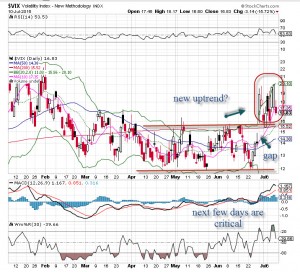 With so much uncertainty over the economic turmoil in Greece and China, it’s no wonder markets have seen a sharp rise in volatility. As measured by the VIX, we saw volatility rise nearly 80% in just two weeks, vaulting from about 12% to 20% during that time.
With so much uncertainty over the economic turmoil in Greece and China, it’s no wonder markets have seen a sharp rise in volatility. As measured by the VIX, we saw volatility rise nearly 80% in just two weeks, vaulting from about 12% to 20% during that time.
Uncertainty creates doubt, and as long as this bull market has been in place, every investor and trader out there has wondered when it may end. However, like Pavlov’s dog, investors are hungry for returns. When we have a huge market rally, like we did on Friday, the saliva glands start working again.
After several days of higher volatility, a lot investors were wondering if the rally was just a blip on the screen like previous pullbacks or was it something to be more concerned about?
Because I follow trends and patterns, I have to use previous moves as my guide – unless the pattern changes. So let’s look at VIX trends.
As we can see from the VIX chart, the recent pop in volatility has been around for a couple of weeks. It spurted higher on news about Greece’s inability to repay its loans and on sudden changes in China’s investment policies to help curb a massive stock market slide. In addition, we learned Puerto Rico was also facing a major debt repayment situation.
The volatility futures curve also shows a rise in fear and concern; the term structure is elevated and spot VIX is also above recent levels. On Friday, the curve got steeper, which was bullish for stocks, but as always we need to see some followthrough. If there is followthrough, the gap in the VIX chart will fill in, and we will likely see the SPX 500 move back up toward the 2100 level.
Just as I mentioned during the webinar last week, the most reliable moves are reactionary and not anticipatory. Trying to guess is just a fool’s game. Yes, we all have to estimate how our ideas will play out, but when trends are obvious, it makes sense to ride them out.
Take the activity of the past two weeks. On Sunday, June 28, it appeared there would be no deal between the EU and Greece; futures tanked hard that night. Then on Monday, June 29, we had a massive down day; the SPX 500 closed down 2% on heavy turnover.
This was a reactionary response, and it paid off. VIX futures went up sharply as expected and started to flash danger signs, which signaled complacency (we always have complacency when volatility is too low – isn’t there always something to worry about?).
Fast forward to this past Thursday, when we saw the markets gap higher and lose the rally the entire day. A lot of investors were positioning for the inevitable: a followthrough to the downside and a sharp decline. Bets were made on this outcome – and those bets were dead wrong. On Friday, we had a nice rally.
Lessons learned:
- Follow VIX trends, not talking heads.
- Wait for the move to happen first, because guessing will cost you money.



















